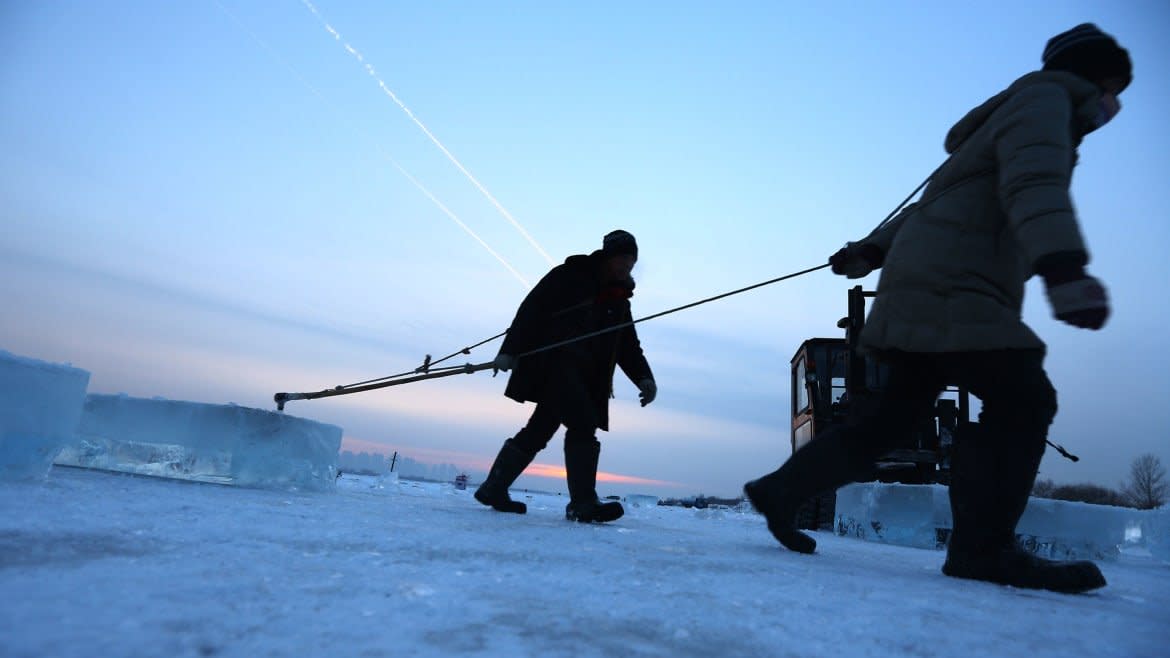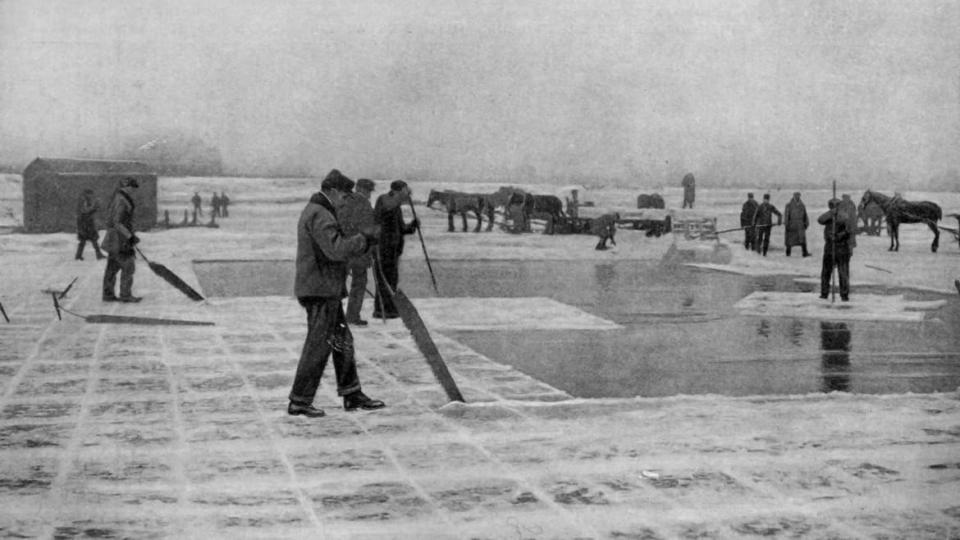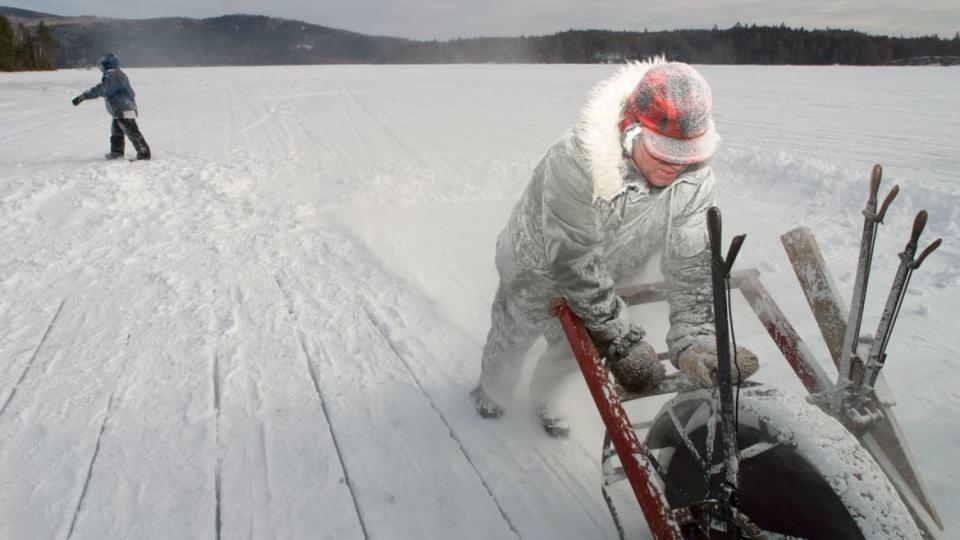How the Ice Cube Lost Its Mystery

I’m isolated in my apartment in Portland, Maine, during a global pandemic. In my tumbler of rye whiskey there floats a large, square ice cube. Outside my window, the ice has retreated with the onset of spring, that renowned Maine ice which at one time—not so long ago—was among the Pine Tree State’s most profitable commodities, like timber, like lobster.
It’s rare that I look at the ice in my glass. Or, better, it’s rare that I see the ice. Few of us do, not in the way that someone two centuries ago would have. We don’t think of the mysteries of frozen water; we don’t ponder its provenance. Indeed, we know where it came from: it came from a plastic tray in the freezer, or it dropped into our glass when we pushed the lever on the refrigerator.
With convenience comes familiarity. But in this case, familiarity doesn’t breed contempt; it breeds blindness. We’ve lost sight of the beauty, the majesty of ice. We take it for granted, this cube, this small reminder of a substance that was once feared and revered. And our world is much the worse for it.
FROZEN IN BATTLE
For ages we had been attacking the ice, slicing into it and carting it southward for urbanites to drop into their Manhattans. Indeed, the very state where I now sit (ice further melting in my glass) once stood at the very center of the 19th century ice trade. Even as Texas cowboys in the 1870s drove their herds northward for slaughter, 25,000 men would amass each winter on the Kennebec ice fields to carve up the river and store it for shipment to cities in the South.
But those who made their livings by chopping up lakes only seemed to enhance the romance. We knew the ice would not be so easy to control. It had been here far longer than us. It had, in fact, ruled this continent long before humans arrived. And when the glaciers, those ancient behemoths, receded back to the north country, they left only riddles for us to solve, claw-marks in the shorn cliffs, where some Old-Testament goliath had swiped the sides from mountains. To those who first laid eyes on them, these glacial remnants must have been stupefying. The Great Lakes and Niagara Falls. The singing sands of Indiana and the waterfalls of Illinois’ Starved Rock State Park. El Capitan.
When humans first came to the North American continent, one can assume they maintained great respect for the power and mystery of ice, even as the frozen monoliths were making their way northward. The Iroquois believed that the ice spirit Flint—also known simply as “Evil”—helped to form the Earth, along with his twin brother, the creator god Sky-holder (“Good”). The Ojibwe told of the wendigos: malevolent, ice-coated giants who devoured men. The Cree, too, believed in cannibalistic ice giants, as did many other tribes: the Micmac, the Maliseet, the Passamaquoddy, the Abenaki and the Penobscot.

Many of the Europeans who arrived to displace and demolish those tribes sought peace through brutally enforced religious enlightenment. They found in the roughhewn landscape of America a New World that had been largely formed by ancient ice. These new arrivals learned to let the land guide them, and they imbued these lands with their own spiritual fervor. A new sort of religion developed, Transcendentalism, wherein it was taught that divinity pervades every aspect of nature. Belief and nature merged. Today, even still, the small mountain lakes braided together by a single stream—those pristine ponds formed ages ago by glaciers—are called “paternoster lakes” due to their resemblance to a Catholic rosary.
DREAMS OF GLACIERS
Ice had a profound effect on the 19th-century American imagination. Before Charles Darwin turned the scientific world on its ear with his theory, it was glaciers that dominated the conversation surrounding the Earth’s age and Biblical truth. In the early 19th century, many great European thinkers had become obsessed with ice, including Johann Wolfgang von Goethe (who, along with being the father of German literature, was also a glaciologist before the term existed), and Samuel Taylor Coleridge, he of the ice-riddled “Rime of the Ancient Mariner.” Here’s Coleridge on glaciers: “Motionless torrents! silent cataracts! / Who made you glorious as the Gates of Heaven / Beneath the keen full moon? Who bade the sun / Clothe you with rainbows?” Coleridge, here was a guy who knew how to appreciate ice.
Meanwhile it was a Swiss geologist, Louis Agassiz, who first disseminated the notion that Europe, Asia, and North America had once been frozen lands. After the 1840 publication of his two-volume work Études sur les glaciers (Studies on Glaciers), Agassiz began reporting on his findings to the Geological Society of London. In doing so, he ignited a firestorm.
The prevailing belief, pre-Agassiz, was that the Earth’s stunning land formations had been formed some 6,000 years previous by the Biblical flood. But Agassiz and the glaciologists who came after him were able to show striations in the ice that proved these leviathans had been around far longer than the Earth’s supposed age.
Then, Agassiz set out for America, and the famed geologist—and by extension ice—entered full force into American discourse, mainly through connections Agassiz formed with his New World contemporaries. After turning Europe upside down with his theories, Agassiz settled at Harvard University, where the Swiss geologist was welcomed into the “Saturday Club,” an elite circle whose members included the poets James Russell Lowell, John Greenleaf Whittier and Henry Wadsworth Longfellow, the botanist Asa Gray, the mathematician Benjamin Peirce, the novelist William Dean Howells, and the philosopher and essayist Ralph Waldo Emerson—perhaps the most important thinker in America. At Harvard, Agassiz would go on to teach some of America’s brightest young minds, including Henry Adams and William James, and ice began to appear in the works of these luminaries.
It was largely because of Agassiz’s celebrity that frozen water was imbued with a sense of cheeky rebellion against received theology. Amid the flowering of the Romantic Age, America’s keenest minds became fixated on the notion that the Earth’s past stretched back untold eons, into times when everything between here and the horizon had been covered with a white, pristine sheen. The image was enough to make even the most hardened New England Brahmin giddy with awe.
POLAR FANTASIES
Over time, the American fascination with ice deepened. It was only a century ago that the great age of polar exploration came to an end. For much of the 19th and early 20th centuries, Americans had ice on the brain. Urban factory workers and housewives in the heartland marveled at the exploits of Byrd, Scott, Amundsen, Shackleton and Peary. In their minds, they traveled up into those icy climes, shivering with those men, fearing the cold with them, and, alongside them, falling in love with the sublime beauty of the frozen world.
As everyday readers followed these polar adventures, ice dreams filtered into our entertainment. In 1936, the science horror writer H.P. Lovecraft published At the Mountains of Madness, which recounted a disastrous 1930 expedition to Antarctica. In the book, the explorers find that the ice at the bottom of the world holds terrors of such magnitude that their feeble human brains can barely comprehend them. And readers believed. Because, over many centuries—even since the dawn of humankind—we’d been trained to fear ice.

Lovecraft himself had, as a boy, become obsessed with the polar reaches—not for their scientific qualities, but for what the ice at the ends of the Earth represented. For centuries, frosty mountaintops and polar climes had been revered within the human psyche as unknowable places, sites inhabited by ghosts and monsters—even gods. Thus, Lovecraft was following in a grand tradition. Edgar Allen Poe’s only novel, The Narrative of Arthur Gordon Pym of Nantucket, ends as the narrator disappears into the ice at the South Pole, where “a chasm threw itself open to receive us.” A decade after the novel’s publication, life would echo fiction, as the explorer Captain Sir John Franklin and his expedition would vanish into the ice, never to be heard from again—thus sparking one of the most extensive and romanticized search efforts in history.
But of course, Lovecraft and Poe were taking their cues from the greatest horror novel of them all. It is no coincidence that, when Frankenstein’s monster tells his story, he does so from within a glacial cave. The “dreary glaciers are my refuge. I have wandered here many days; the caves of ice, which I only do not fear, are a dwelling to me.”
THE DEATH OF ICE
Today, as we are all too aware, the Earth’s literal ice is melting. But the romantic idea of ice has long been moribund, dying a slow death by a million cuts. It died a bit when Frederick Cook and Robert E. Peary squabbled over who had first discovered the North Pole. It further succumbed when Roald Amundsen stabbed his flag into the South Pole. It withered when Edmund Hillary and Tenzing Norgay summited Everest. It dies a little each time we intimately photograph it from outer space, each time a strand of new tourists traipses across Everest’s peaks, each time we poke another drill bit into the tundra.
But the true demise of ice’s power came with the invention of refrigeration.
While humans have been able to make fire since the beginning of civilization, the ability to create ice eluded us until relatively recently. Before refrigeration, the nature of ice forced us to respect it, frequently killing those who dared explore it or attempted to mine it. Hearty souls took their lives into their hands, trudging into the northern realms to saw into the beast and cart pieces of it back to civilization, as if the frozen blocks were rhino horns or leopard pelts.
But today, even as icebergs the size of Boston break free from Antarctic glaciers and float away like cubes in a colossal cocktail, we find ice ready at hand in our homes. Perhaps, we pour too many pellets into our cup at the 7-Eleven, so we dump the surplus out and hit the lever again. Sometimes, in our freezers, we can hear the ice creaking and cracking, as Shackleton must have. We may detect its rumblings in the top of the machine at the movie theater. When we push the lever and the ice doesn’t obediently drop into our cup, we grow frustrated. We tell the manager. Then we go sit in the air-conditioning.
And it is that air-conditioning that is killing the ice most of all. By midcentury, the Earth is expected to have nearly 6 billion air-conditioners, humming softly into the night. As we sit by the window unit and sip our Manhattans, the ice at the ends of the Earth groans in pain. And another city-sized chunk drops into the sea.
REDISCOVERING THE ROMANCE
As a young man, growing up among the glacial plains of Wisconsin, John Muir, the great American naturalist and future founder of the Sierra Club, was obsessed with productivity. The young Muir invented all kinds of clocks and contraptions, including a desk that rotated the book in front of the reader after an allotted time of studying, and an alarm-clock bed that tipped the sleeper onto the floor when it was time to awaken. Later, in his twenties, Muir would travel to Indiana to become what we would now call an efficiency expert in a carriage-wheel factory, where he continued meticulously counting minutes and seconds.
And then, during a rare total solar eclipse in 1867, tragedy struck—and Muir’s life changed forever. While tightening a belt on a shop machine, he lost his grip and sent a metal awl flying like a dart into his eye. As fluid from his eyeball dripped down his cheek, Muir turned calmly to a fellow worker and said: “My right eye is gone, closed forever on all God’s beauty.”
Hours later, Muir’s other eye failed too. He lay in a dark room for a month and a half, until he became transformed. He vowed that if he ever saw again, he would travel the Earth looking upon God’s creation. When he finally—and miraculously—regained sight in both eyes, he was a different man. He no longer thought in minutes and seconds—now he thought in epochs. He left Indiana and walked all the way to the Gulf of Mexico. Then he sailed to Cuba, and then onward to California, where he made a life among some of the oldest living things on Earth, the Golden State’s redwoods and sequoias.
In California, Muir shunned short-lived humanity and began to think about glaciers, whose striations counted far more years than even those ancient redwoods. He became convinced—before anyone had conceived the idea about the region—that his new home had been formed by ancient glaciers. And he wrote of them, with his mind turned away from life’s minutia and focused on the slow and gentle passing of millennia, wherein he was but a mote:
In the waning days of this mountain ice, when the main river began to shallow and break like a summer cloud, its crests and domes rising higher and higher, and island rocks coming to light far out in the main current, then many a tributary died, and this one, cut off from its trunk, moved slowly back amid the gurgling and gushing of its bleeding rills, until, crouching in the shadows of this half-mile hollow, it lived a feeble separate life. Here its days come and go, and the hiding glacier lives and works. It brings boulders and sand and fine dust polishings from its sheltering domes and cañons, building up a terminal moraine, which forms a dam for the waters which issue from it; and beneath, working in the dark, it scoops a shallow lake basin. Again the glacier retires, crouching under cooler shadows, and a cluster of steady years enables the dying glacier to make yet another moraine dam like the first; and, where the granite begins to rise in curves to form the upper dam, it scoops another lake. Its last work is done, and it dies.
Maybe we, too, can stop for a minute to think of the ice tinkling in our glasses. Think of how hard it has been to come by, how many centuries it took to conquer it and relieve it of its romance. Perhaps, as we sip our Manhattans, we might think of how this translucent stuff once ruled this continent. We might think of how the substance within this tiny cube has the power to move mountains, how staying cool has come at the expense of something grand—something eternal, even.
Next time, we push that lever on the refrigerator, maybe we will think about the cubes that come clattering out. Maybe we will think of those lost souls, long-ago frozen on the poles, and of the monsters and witches that once inhabited the Earth’s ice caves. Maybe we will turn off that window unit and listen to the evening, sipping our cocktails in silence. And maybe, in our minds, we will once again travel northward.
Get our top stories in your inbox every day. Sign up now!
Daily Beast Membership: Beast Inside goes deeper on the stories that matter to you. Learn more.

 Yahoo News
Yahoo News 
